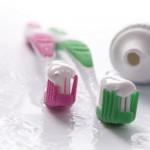
The aim of this single-blind cross-over study was to compare the performance of three different toothbrush models in the control of dental biofilm and maintaining a healthy gingival condition.
The sample was randomly divided into three groups (A, B and C), each of which used one of the three toothbrushes tested. The brushes had bristles on the same plane, straight (T1) – bristles on different planes, straight arrangement (T2) bristles on different planes, straight and circular arrangement( T3). Each experimental period lasted 15 days each, with three daily brushings and a 7-day washout interval was used between periods. The oral hygiene and gingival bleeding indices were recorded by a single, calibrated examiner blind to the brush used. Bristle wear was measured with a digital calliper at the end of each period.
They found that :-
- The toothbrushes achieved similar results for the clinical parameters investigated (P > 0.05).
- The three models exhibited a similar degree of bristle wear (P > 0.05).
The authors concluded that:-
the arrangement of the bristles had little influence over the removal of biofilm and gingival conditions. Thus, there is no clinical justification for replacing conventional toothbrushes with more expensive models.
Stroski ML, de Souza Dal Maso AM, Wambier LM, Chibinski AC, Pochapski MT, Santos FA, Wambier DS. Clinical evaluation of three toothbrush models tested by schoolchildren. Int J Dent Hyg. 2011 May;9(2):149-54. doi:10.1111/j.1601-5037.2010.00476.x. PubMed PMID: 21356018.

buen dia, felicidades por su investigacion, quiero preguntarle que es mejor si un cepillo de cerdas blandas o un cepillode cerdas duras?
Ramon
Thank you for you question which I think is ‘good day, congratulations on your research, I ask which is better if a soft-bristled brush or a hard-bristled bristle? This is an interesting question as I am not personally aware of any definitive evidence one way or another. The Department of Health ‘An evidence-based toolkit for prevention’ states
‘Brushing is more effective with a small-headed toothbrush with soft (ISO 8627:1987 standard 1–3), round-ended filaments, a compact, angled arrangement of long and short filaments and a handle which is comfortable’ and suggests that there is level V evidence to support this . While a study by
Zanatta FB, Bergoli AD, Werle SB, Antoniazzi RP. Biofilm removal and gingival abrasion with medium and soft toothbrushes. Oral Health Prev Dent. 2011;9(2):177-83. PubMed PMID: 21842020.
finds that ‘ Medium toothbrushes have a greater ability to remove biofilm and cause gingival abrasion than do soft toothbrushes.’ Based on simple mechanics it seems sensible to conclude that a hard brush is likely to be more abrasive than a softer one.